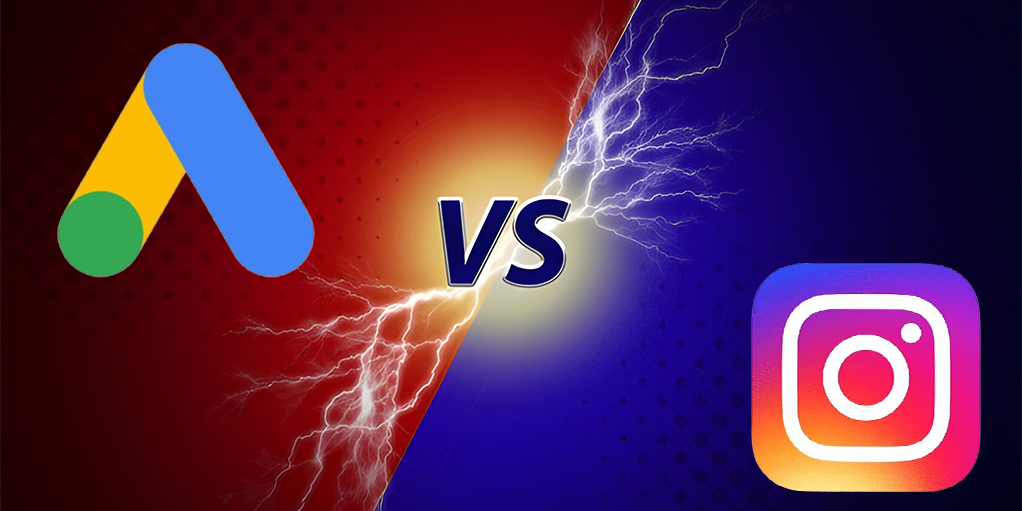Introduction
In the rapidly evolving world of digital marketing, businesses have more advertising platforms than ever. Among the most prominent are Google Ads and Instagram Ads, which offer unique advantages and cater to different aspects of consumer behavior. However, deciding which platform to invest in can be challenging. This blog will provide a detailed comparison of Google Ads and Instagram Ads, helping you determine which platform best suits your business goals.
Understanding Google Ads
Google Ads, the rebranded version of Google AdWords, is one of the oldest and most effective online advertising platforms. It allows businesses to display ads on Google’s search engine results pages (SERPs), YouTube, and across a vast network of partner websites through the Google Display Network. Google Ads primarily operates on a pay-per-click (PPC) model, where advertisers bid on keywords relevant to their products or services, and only pay when a user clicks on their ad.
Key Advantages of Google Ads:
- High Intent Traffic: One of the most significant advantages of Google Ads is its ability to capture high-intent users. When someone searches on Google, they often have a specific need or question in mind, making them more likely to convert when they see a relevant ad.
- Extensive Reach: Google processes billions of searches every day, offering an unparalleled reach. Whether through search, display, or video ads on YouTube, Google Ads can help you connect with a massive global audience.
- Precise Targeting: Google Ads offers various targeting options, including keyword targeting, demographic targeting, location-based targeting, and retargeting. This allows businesses to tailor their ads to specific audiences, increasing the chances of reaching potential customers.
- Detailed Analytics: Google Ads provides comprehensive analytics, allowing advertisers to track the performance of their campaigns in real time. This data-driven approach enables businesses to optimize their campaigns for better results.
Understanding Instagram Ads
Instagram Ads are part of the broader Meta (formerly Facebook) advertising ecosystem. With over a billion monthly active users, Instagram is a visually-driven platform, making it ideal for businesses with strong visual content. Instagram Ads appear seamlessly within the user experience, often indistinguishable from organic content, and can take various forms, including image, video, carousel, and story ads.
Key Advantages of Instagram Ads:
- Visual Engagement: Instagram is inherently a visual platform, perfect for brands that can create compelling imagery and video content. The platform’s emphasis on aesthetics allows businesses to tell their brand story in a visually engaging way.
- Highly Engaged Audience: Instagram users are known for their high levels of engagement, making it an excellent platform for brands looking to foster connections and build a community. Features like likes, comments, and shares help amplify the reach of your ads.
- Advanced Targeting: As part of the Meta ecosystem, Instagram Ads benefit from the robust targeting capabilities of Facebook Ads Manager. Advertisers can target audiences based on demographics, interests, behaviors, and connections, ensuring their ads reach the most relevant users.
- Seamless Integration: Instagram Ads blend seamlessly into users’ feeds and stories, making them less intrusive and more likely to be viewed and interacted with. This native advertising approach helps brands connect with users in a natural and engaging way.
Comparing Google Ads and Instagram Ads
- Audience Reach and Behavior
- Google Ads: Google Ads excels at capturing users with high intent. When people use Google to search for something specific, they are often ready to take action, whether that’s making a purchase, signing up for a service, or seeking information. This makes Google Ads particularly effective for driving conversions.
- Instagram Ads: Instagram Ads are more focused on engagement and brand building. The platform’s users typically browse content casually, often without a specific intent. As a result, Instagram Ads are well-suited for raising brand awareness, generating interest, and building a loyal following over time.
- Ad Formats and Creative Flexibility
- Google Ads: Google offers a variety of ad formats, including text-based search ads, image-based display ads, and video ads on YouTube. These formats are practical but often require a more structured approach, with less room for creative expression compared to Instagram.
- Instagram Ads: Instagram is built for creativity, offering numerous ways to showcase your brand through images, videos, carousels, and interactive content like stories. This flexibility allows brands to craft visually stunning ads that resonate with their audience and encourage interaction.
- Targeting Capabilities
- Google Ads: Google’s targeting is heavily based on keywords and search intent, which is perfect for capturing users actively looking for specific products or services. Additionally, Google offers demographic, geographic, and retargeting options, providing a comprehensive suite of targeting tools.
- Instagram Ads: Instagram’s targeting is based on user data from both Instagram and Facebook, allowing for highly detailed audience segmentation. This makes Instagram particularly effective for demographic targeting and interest-based advertising, enabling brands to reach users who align closely with their ideal customer profile.
- Cost and Return on Investment (ROI)
- Google Ads: The cost of Google Ads can vary significantly depending on the competitiveness of the keywords you’re bidding on. While it can be expensive, especially for highly competitive keywords, the high intent of users often leads to a strong ROI, particularly for conversion-focused campaigns.
- Instagram Ads: Instagram Ads tend to be more cost-effective, especially when targeting specific demographics or interest groups. The platform’s focus on engagement means that businesses can often achieve impressive results with a smaller budget, making it a viable option for brands looking to build awareness or engagement without breaking the bank.
Which Platform is Right for Your Business?
The choice between Google Ads and Instagram Ads depends largely on your business goals, target audience, and the nature of your products or services.
Choose Google Ads if:
- Your primary goal is to drive direct conversions, such as sales or lead generation.
- You want to capture high-intent users actively searching for your products or services.
- You must reach a broad audience through search, display, or video ads.
Choose Instagram Ads if:
- Your brand has a strong visual identity and can benefit from creative, visually-driven content.
- You aim to build brand awareness, foster engagement, or create a community around your brand.
- You want to reach a younger, highly engaged audience on social media.
Conclusion
Both Google Ads and Instagram Ads offer powerful tools for digital marketers, but each excels in different areas. By understanding the strengths and limitations of each platform, you can choose the one that best aligns with your marketing objectives. Whether you’re looking to capture intent-driven search traffic with Google Ads or engage users with compelling visual content on Instagram, selecting the right platform will ensure your advertising efforts are both effective and efficient.
To know more about Google Ads, Please visit https://paypercampaign.com/google-ads/





